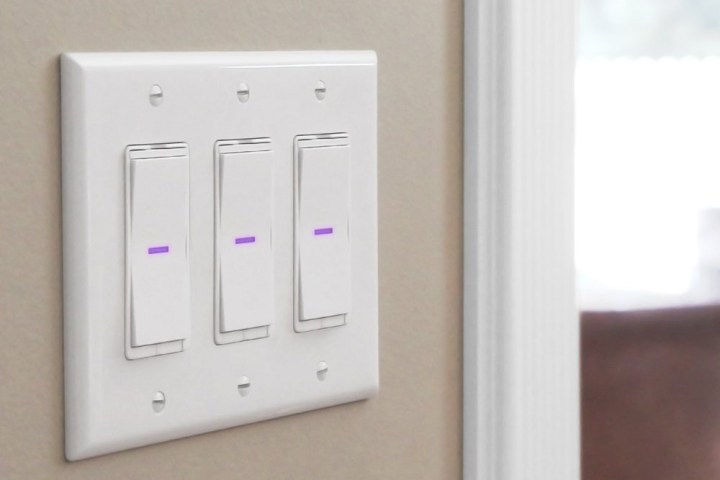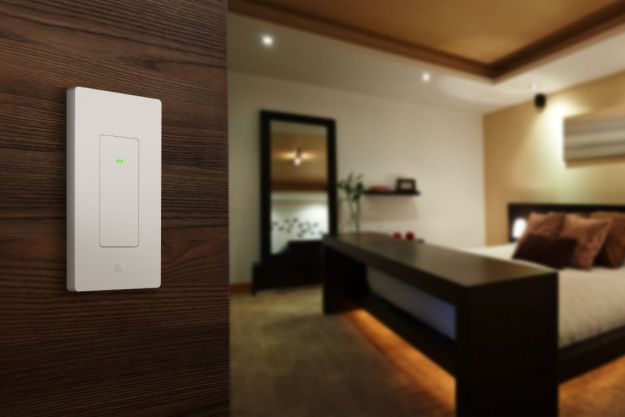
You’re probably familiar with those regular old light switches that you fumble for in the dark, but maybe you’re unclear on what a smart switch is. Good news: you’ve come to the right place.
A smart switch is still a light switch, but with advanced features that help automate your home. They resemble traditional switches and plug into the same spaces that traditional outlets are found, except:
- They have radio wave capabilities that allow the switches to connect to a nearby wireless network and become part of the Internet of Things. This makes the devices “smart” and gives them an array of capabilities, including app or voice control.
- Their design tends to be a bit more complicated. Some may have extra buttons for more specific light control, while others may come with additional sensors or light indicators.
Smart switches provide a solution for upgrading current light switches that you use every day, typically for built-in lights (as opposed to lamps, which are upgraded with smart plugs instead). Smart switches tend to cost around $50: At this price, You may not want or need to upgrade every switch in your house, but there are probably a few light switches that see very frequent use—these would make good candidates for a smart upgrade.
Benefits of using a smart switch
To get a better idea of how smart switches work and whether or not you want one, let’s look at the benefits and features that these switches provide. Note that other smart devices like smart bulbs also offer similar capabilities, but smart switches tend to be the most cost-effective solution if you’re already happy with your bulbs.
App controls: Smart switches often come with their own smart device app, based on the brand. You can download this app and use it to control the connected light from a mobile device. This means you don’t technically have to use the switch at all, although it’s still handy to have. For example, if you’re on vacation, you could turn on your light at home so that people think someone’s home.
Dimming options: Dimming does depend on the bulbs you are controlling, as not all bulbs support dimming, especially CFL bulbs. However, if your lights are compatible, most smart switches provide dimming options to control brightness until you find the levels you want. You do not need to have a dimmer installed on the actual switch on the wall. Advanced versions can automatically change brightness settings throughout the day, so you get lighter as it grows darker outside.
Smart bulb control: You can control both smart bulbs and smart switches remotely, but you can also link them together in interesting ways. Program a smart switch to turn on smart bulbs through your house, and it will manage those bulbs as well as the lights that it is wired to.
Scheduling: Most smart switch apps also allow you to create schedules for your lighting. This is an increasingly common way of saving energy and providing some extra convenience around the house: You can program lights to come up as you are heading home from work, for instance, or set a vacation program that only keeps a couple lights on at night for safety.
Sensors: Not all smart switches have sensors, but many do. The two most common are the motion sensor, which can detect movement and turn on lights automatically (common in office buildings for energy savings), and the touch sensor that’s used as a modern way of turning the light on and controlling the dimmer.
Integration with more advanced setups: Connect your smart switch to a whole ecosystem of smart devices, and you will quickly find that it can interact in a number of useful ways. You can create “scenes” with your lights that include automatic operation of multiple smart devices at one time. For example, you can connect your lights via the switch to a distant motion sensor, and have the lights turn on when motion is detected. Little scenes like these can change the way that you use your lights.
Compatibility with platforms: Modern smart switches have built-in compatibility with many different platforms for extra scenes, voice commands, and the ability to control the switch and other devices from the same app. When shopping for a switch, you might want to double check compatibility with Amazon Alexa, Google Assistant, Apple HomeKit, Wink, Next, or IFTTT, depending on what you prefer to use.
A note about wiring

Smart switches tend to require a neutral wire when you first install them. This isn’t a problem for the average home, because neutral wires are included in the switches of most modern houses built within the last several decades.
However, if your house has particularly old switches, or if it was renovated with switches that do not include neutral wires, you may not be able to use smart switches. In this case, it’s better to stick with smart bulbs instead, which only need the right socket to screw into.
In some cases, electrical load may also be an issue, such as with more complex dimmers. If this is a concern to you, make sure the smart switch you choose is phase adaptive so it will work with your current dimming bulbs.
Editors' Recommendations
- Echo Hub vs. Echo Show 8: Which is the best option for your smart home?
- What is IFTTT and how can you use it in your smart home?
- I checked out Govee’s new AI smart lights and now I want them everywhere
- Nanoleaf upgrades its music-syncing skills, launches new lighting products at CES 2024
- How to save money with your smart home this winter




